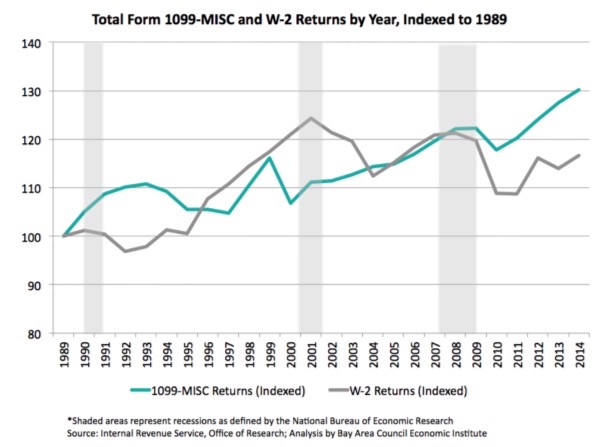Written by Technically Media CEO Chris Wink, Technical.ly’s Culture Builder newsletter features tips on growing powerful teams and dynamic workplaces. Below is the latest edition we published. Sign up to get the next one.
That’s a remarkable spike from 2020 when the total was one in four.
Where those figures go next will say a lot about stubbornly unanswered questions surrounding the US economy. Economic downturns have fueled contract labor booms for the last 30 years. One of the biggest questions at this stage of American pandemic life is how rough the water ahead will actually be. Add freelance work to the long list of economic trends the pandemic has accelerated.
“That means that more and more people are finding their careers as freelancers today,” said Margaret Lilani, VP of Talent Solutions from Upwork, a publicly traded platform for connecting employers to independent contractors. According to the company’s recently released annual report, freelance labor represented $1.3 trillion of the US economy.
Choosing a preferred schedule and workload marks a generational shift, the report argues. Upwork CEO Hayden Brown has said that nearly half of Gen Z workers already freelance in one form or another. Brown predicts that a majority of the country’s workforce will be freelancing by 2027.
Contract labor is a tale of two lifestyles — and varying terms
Top earners are in knowledge work — imagine the elite independent graphic designer or the influential salaried professional who books speaking gigs on the side. Those are the people who hawk their skills on Upwork. But the fastest growing segment of contractors earn poverty wages, typified by the sharing economy hustler or the gig-working creative.
These are two vastly different narratives that nonetheless still contribute to the freelancer economy. In all these examples, women outpaced men in their reliance on flexible contract work.
“Together, these trends suggest that the long-run growth” in independent contractors, according to a July 2019 paper produced for the IRS, “may represent a structural shift in the labor market, particularly for women.”
It’s worth settling on a bit of vocabulary for all these short-term, project-based workers. Freelancers, contractors and consultants are all subtly different terms that imply similarly mixed contributions. New generations spawn new terms. In 1985, labor economist Audrey Freedman called them “contingent workers.” Then, the term “gig economy” was coined in 2009 to describe the growing number of professionals leveraging online platforms to cobble together full-time wages on their own terms.
These terms all feel incomplete because, perhaps, the clearest way to differentiate the nearly 60 million Americans Upwork says freelanced in 2021 is their level of control. The web developer choosing what projects she undertakes is an economic winner designing work in her own image. The grandmother picking up seasonal work to combat a burst of inflation could be taking what she can get. Both are contractors, even if all they might share in common is tax compliance: They both likely receive “1099 income” — jargon to describe the tax form for contract work, which is different from the so-called W-2 that full-time employees receive from their employers.
Upwork’s Lilani, like doubtless many others, is keen to focus on those empowered by freelance work. Employers get to call on outside expertise while skilled professionals willing to trade inconsistency for greater flexibility get the control they desire.
“Those are going to be folks who are experts in their field and have chosen, as a career, to go forward and be independent and take their skills to businesses of all sizes,” Lilani said. She added that this higher-earning end of the freelancing spectrum grew fastest during the pandemic. But the vast size of the freelancer economy ensures it’s more complex — even within high-wage, high-demand fields like software and technology.
Hidden in plain sight?
Last year, a pressure group called The Tech Equity Collaborative released a report criticizing “tech’s shadow workforce.” The advocacy group contends that tech industry contractors are worse paid and more likely to be people of color than their full-time counterparts.
“The tech industry is in fact diverse,” the group has argued, “but that diversity is concentrated in the worker groups with the least power.” Or, as the Aspen Institute’s follow-up publication report put it: “Temporary, contract and contingent workers who work in tech have been largely locked out of the industry’s prosperity.”
That may be true. But the macroeconomic trend goes far beyond tech jobs, spreading so widely that it’s hard to attach to a simple narrative.
Reliance on contractors surged during the pandemic. While small firms once relied even more heavily on contractors, companies with over 25 employees began to catch up, per data from HR platform Gusto. Most employers now rely on contractors for core business functions, said Upwork. Moreover, the Bay Area Council Economic Institute reported that the number of tax returns with 1099 forms has surged past those with W-2s.

If the US economy actually falls into recession (which is not guaranteed), one might expect the reliance on contract labor to grow even more. The shift is already happening. In the back half of last year, according to LinkedIn, employers posted a quarter more contract positions than in the same period of 2021. But like with so many COVID-19-era economic trends during this, comparing one crazy year to a previous crazier year doesn’t ensure a rational prediction of what comes next.
Though contractor workers appear in nearly every industry and across the socioeconomic spectrum, there are similarities. McKinsey research indicates that freelancers are far more optimistic about their futures and the broader US economy than the average American worker. That point appears in Upwork’s data, too.
“Something bigger is happening,” Lilani said. “That’s what we should pay attention to.”







